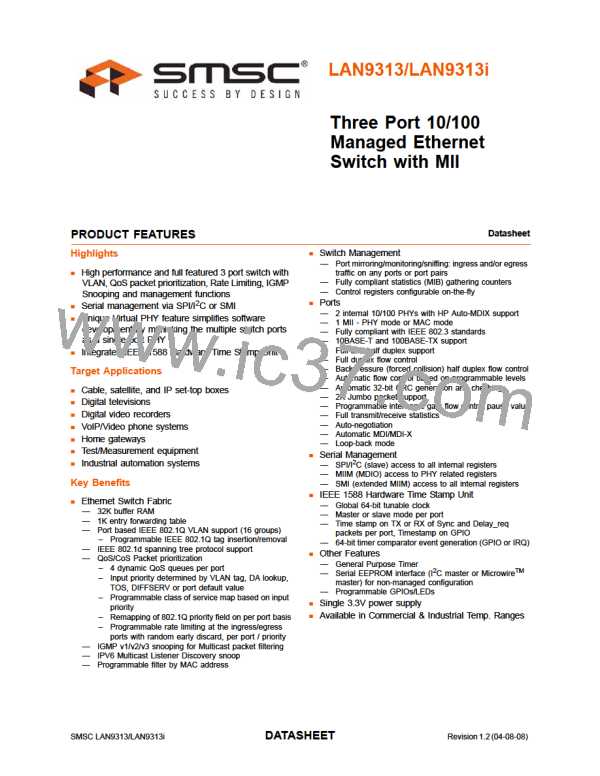Three Port 10/100 Managed Ethernet Switch with MII
Datasheet
100Mbps Full Duplex (highest priority)
100Mbps Half Duplex
10Mbps Full Duplex
10Mbps Half Duplex (lowest priority)
For example, if the full capabilities of the Virtual PHY are advertised (100Mbps, Full Duplex), and if
the link partner is capable of 10Mbps and 100Mbps, then auto-negotiation selects 100Mbps as the
highest performance mode. If the link partner is capable of half and full-duplex modes, then auto-
negotiation selects full-duplex as the highest performance operation. In the event that there are no bits
in common, an emulated Parallel Detection is used.
The Virtual PHY Auto-Negotiation Advertisement Register (VPHY_AN_ADV) defaults to having all four
ability bits set. These values can be reconfigured via software. Once the auto-negotiation is complete,
any change to the Virtual PHY Auto-Negotiation Advertisement Register (VPHY_AN_ADV) will not take
affect until the auto-negotiation process is re-run. The emulated link partner default advertised abilities
in the Virtual PHY Auto-Negotiation Link Partner Base Page Ability Register
(VPHY_AN_LP_BASE_ABILITY) are dependant on the MII_DUPLEX pin and the duplex_pol_strap_mii
and speed_strap_mii configuration straps as described in Table 13.6 of Section 13.1.7.6, "Virtual PHY
Auto-Negotiation Link Partner Base Page Ability Register (VPHY_AN_LP_BASE_ABILITY)," on
page 218. Neither the Virtual PHY or the emulated link partner support next page capability, remote
faults, or 100BASE-T4.
Note: The MII_DUPLEX, duplex_pol_strap_mii, and speed_strap_mii inputs are considered to be
static. Auto-negotiation is not automatically re-evaluated if these inputs are changed.
If there is at least one common selection between the emulated link partner and the Virtual PHY
advertised abilities, then the auto-negotiation succeeds, the Link Partner Auto-Negotiation Able bit 0
of the Virtual PHY Auto-Negotiation Expansion Register (VPHY_AN_EXP) is set, and the technology
ability bits in the Virtual PHY Auto-Negotiation Link Partner Base Page Ability Register
(VPHY_AN_LP_BASE_ABILITY) are set to indicate the emulated link partners abilities.
Note: For the Virtual PHY, the auto-negotiation register bits (and management of such) are used by
the PMI. So the perception of local and link partner is reversed. The local device is the PMI,
while the link partner is the switch fabric. This is consistent with the intention of the Virtual PHY.
7.3.1.1
Parallel Detection
In the event that there are no common bits between the advertised ability and the emulated link
partners ability, auto-negotiation fails and emulated parallel detect is used. In this case, the Link
Partner Auto-Negotiation Able (bit 0) in the Virtual PHY Auto-Negotiation Expansion Register
(VPHY_AN_EXP) will be cleared, and the communication set to half-duplex. The speed is determined
by the speed_strap_mii configuration strap. Only one of the technology ability bits in the Virtual PHY
Auto-Negotiation Link Partner Base Page Ability Register (VPHY_AN_LP_BASE_ABILITY) will be set,
indicating the emulated parallel detect result.
7.3.1.2
7.3.1.3
Disabling Auto-Negotiation
Auto-negotiation can be disabled in the Virtual PHY by clearing bit 12 (VPHY_AN) of the Virtual PHY
Basic Control Register (VPHY_BASIC_CTRL). The Virtual PHY will then force its speed of operation
to reflect the speed (bit 13) and duplex (bit 8) of the Virtual PHY Basic Control Register
(VPHY_BASIC_CTRL). The speed and duplex bits in the Virtual PHY Basic Control Register
(VPHY_BASIC_CTRL) should be ignored when auto-negotiation is enabled.
Virtual PHY Pause Flow Control
The Virtual PHY supports pause flow control per the IEEE 802.3 specification. The Virtual PHYs
advertised pause flow control abilities are set via bits 10 (Symmetric Pause) and 11 (Asymmetric
Pause) of the Virtual PHY Auto-Negotiation Advertisement Register (VPHY_AN_ADV). This allows the
Virtual PHY to advertise its flow control abilities and auto-negotiate the flow control settings with the
SMSC LAN9313/LAN9313i
Revision 1.2 (04-08-08)
DATA9S9HEET

 SMSC [ SMSC CORPORATION ]
SMSC [ SMSC CORPORATION ]